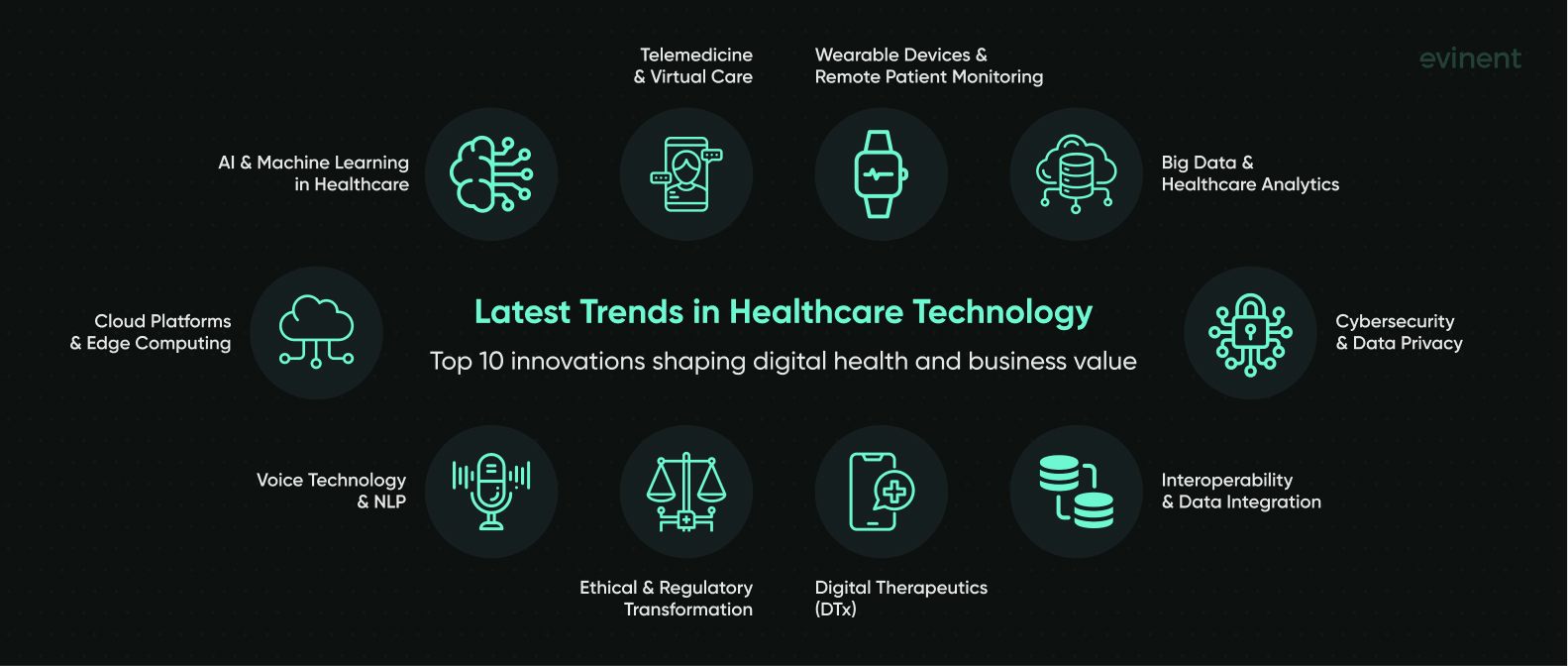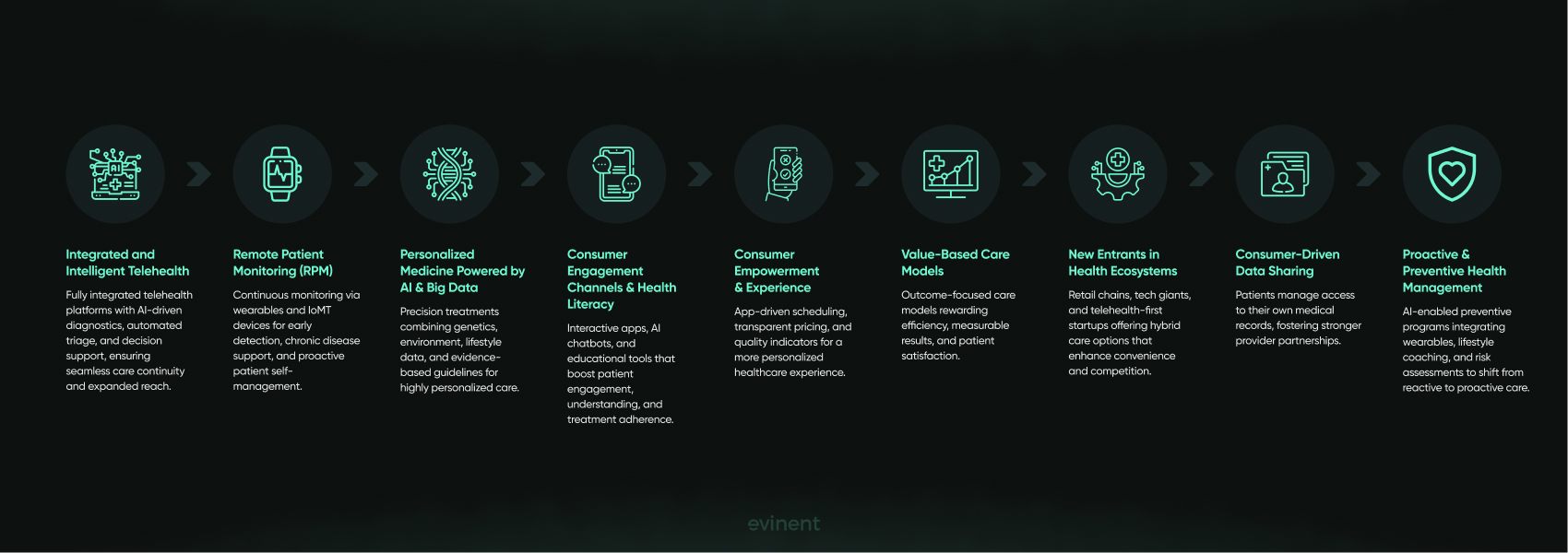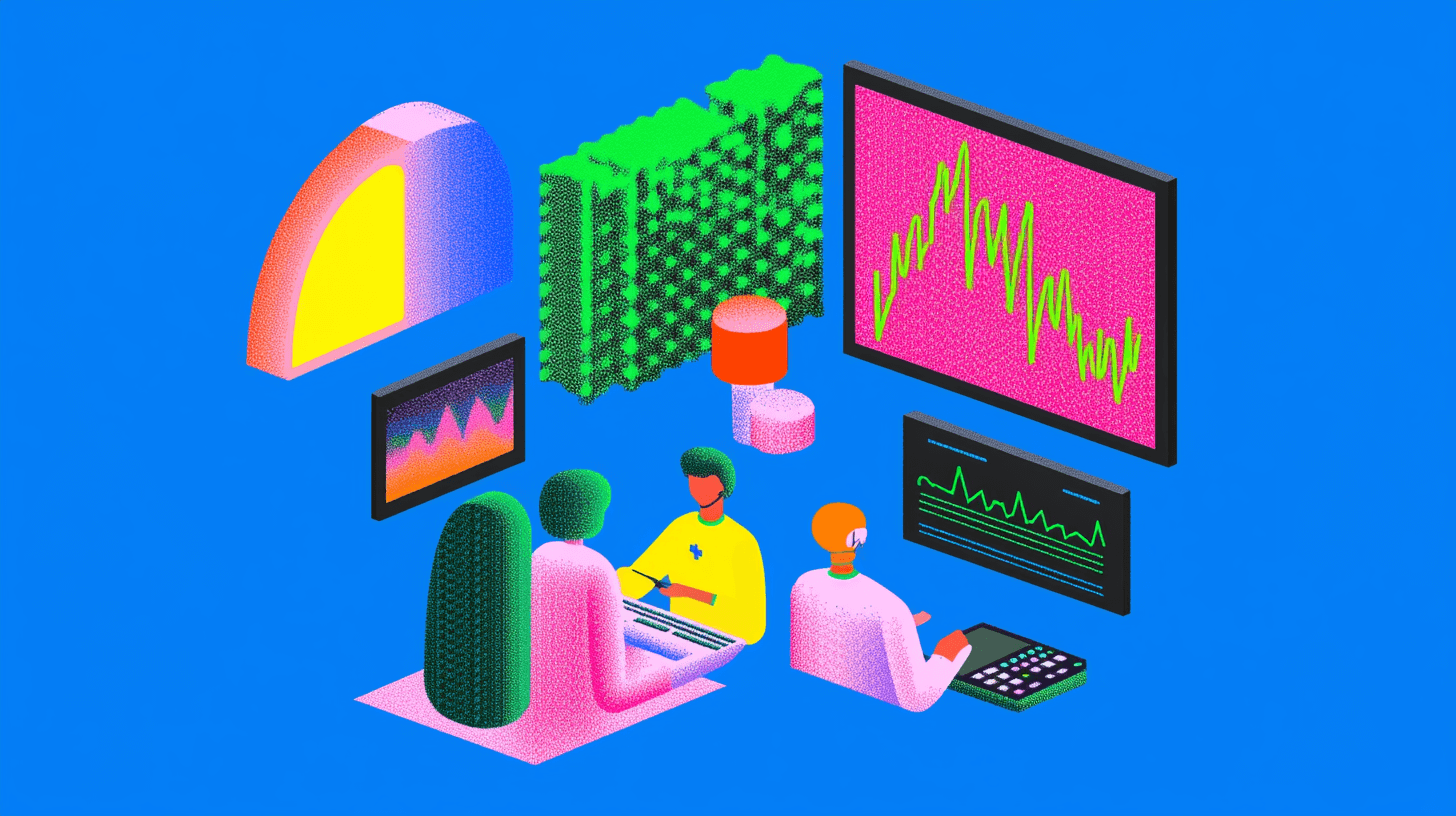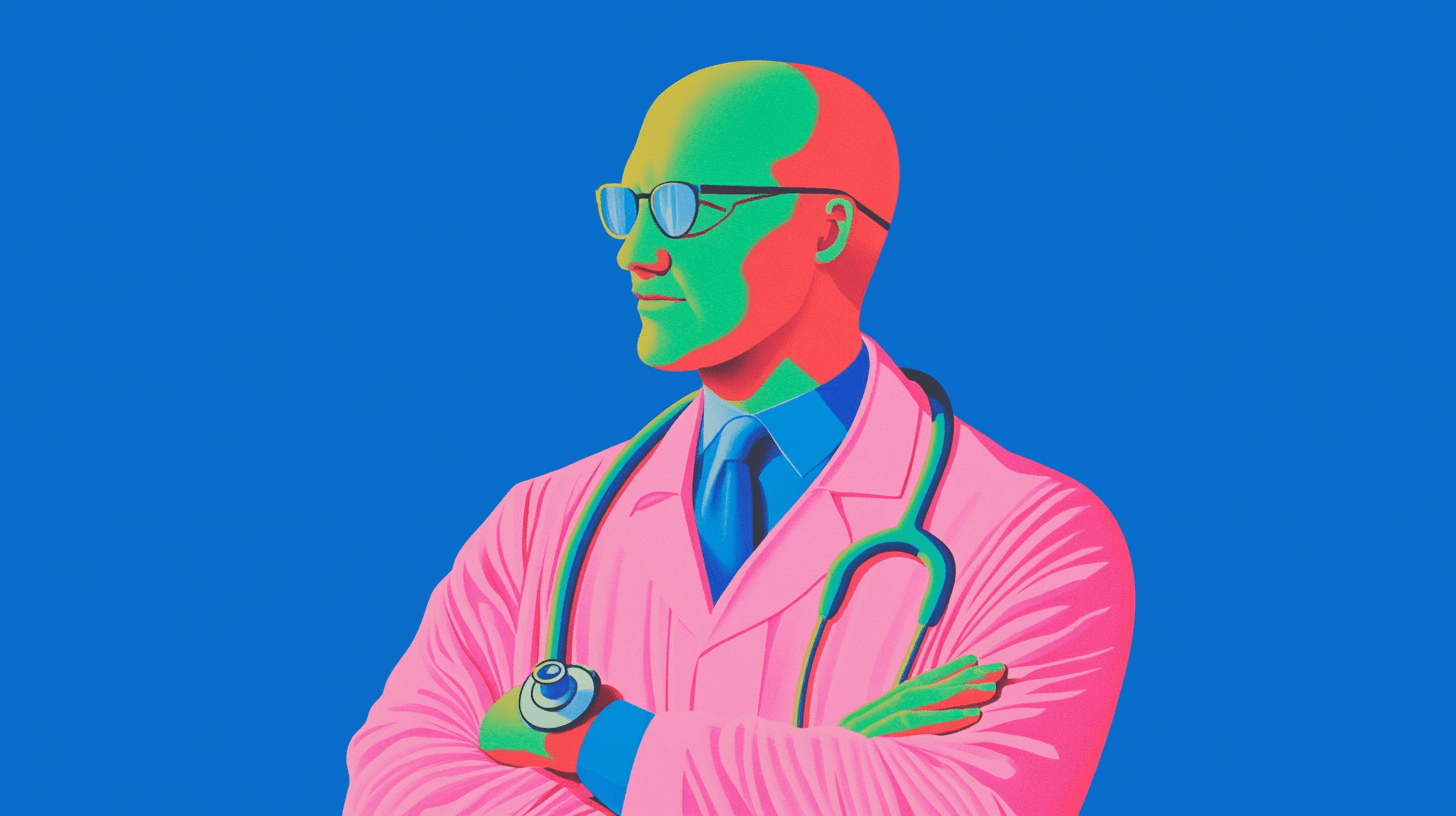Healthcare in 2025 is a curious blend of data-driven clarity and personalized healthcare experiences. AI-powered diagnostics scoring precise hits. Digital platforms giving patients control. Eco-aware tech quietly shrinking carbon footprints. It’s today’s fast-moving reality of healthcare IT trends, health technology trends, and emerging technology trends in healthcare.
It’s not a distant dream. It’s already happening. The global healthcare IT market is expected to hit $880.6 billion in 2025, growing fast as hospitals, clinics, and startups all race to make care more connected, more personalized, and less of a headache for everyone. These healthcare IT industry trends are no longer optional; they’re shaping the technology trends in healthcare industry on a global scale.
The big shift? Tech isn’t just bolted onto existing systems anymore; it’s woven into the way care is planned, delivered, and paid for. That means smarter decisions, faster answers, and hopefully, happier patients. From digital healthcare trends to healthcare software trends, the current trends in healthcare technology are accelerating transformation.
Artificial Intelligence in Healthcare
Artificial intelligence is front and center in medical technology trends. In 2025, it’s being used to improve clinical decision-making, streamline hospital operations, and inspire new ways to deliver care. AI agents, genAI tools, and AI governance toolkits are embedded into workflows to ensure ethical use of AI in clinical documentation and clinical informatics.
Picture this: you wrap up a patient consultation and, before you’ve even left the room, ambient listening AI has drafted the notes, suggested follow-up tests, and flagged an anomaly in diagnostic algorithms that could have gone unnoticed. Predictive analytics supports these systems, making healthcare and technology trends more precise than ever.
The most visible change is in clinical documentation. Tools with ambient listening capabilities capture key details during consultations (with patient consent), summarize them accurately, and reduce hours of paperwork. AI in medical imaging improves detection rates, while large language models integration helps analyze unstructured patient data.
AI is also powering predictive analytics for early diagnosis, helping care delivery models detect risks before escalation. Behind the scenes, AI agents optimize staffing, supply chains, and workflow integration to reduce staff burnout and manage clinical labor shortages.
10 Healthcare Technology Trends
In 2025, healthcare technology trends are defined by innovations that are data-driven, patient-centered, and deeply integrated into everyday care. Advances in AI, digital care navigator platforms, remote patient monitoring, and interoperability are making healthcare more precise, accessible, and efficient, while also opening new business opportunities. These technological trends in healthcare include:
1. AI and Machine Learning in Healthcare
Artificial Intelligence (AI) and Machine Learning (ML) have moved from pilot programs to full-scale operational use across clinical and administrative workflows.
Generative AI for clinical support: AI tools now produce structured summaries of patient interactions, highlight critical details in medical histories, and assist in treatment planning. Integrated into EHRs, they save hours of manual work for physicians and nurses.
Predictive analytics for early diagnosis: Advanced ML models detect subtle, early indicators of diseases, from cancer biomarkers to heart rhythm changes, long before symptoms appear. These models combine clinical data, imaging, and genetic profiles for more precise risk assessments.
Decision support systems for doctors: Embedded within clinical software, AI engines present context-aware recommendations during consultations, ensuring clinicians make faster and more informed decisions.
AI in imaging & diagnostics: Radiology and pathology are being transformed by AI that can scan thousands of images in seconds, improving detection rates for tumors, fractures, and internal bleeding.
Digital twins for treatment planning: Virtual replicas of patients’ organs or full physiological systems allow clinicians to test surgical approaches, simulate drug responses, and personalize rehabilitation programs, reducing trial-and-error in patient care.
Business impact: AI improves patient outcomes, cuts diagnostic times, and optimizes hospital resource allocation, driving both quality improvements and cost savings.
2. Telemedicine and Virtual Care
Telehealth has evolved from a pandemic-era necessity to a core pillar of hybrid care models.
Remote consultations: Routine follow-ups, chronic disease management, and preventive screenings are increasingly handled via secure video platforms, expanding access to specialists regardless of geography.
Integrated hybrid care: Patients can seamlessly move between in-person visits and virtual check-ins, supported by unified health records.
AI triage & diagnostics: Telehealth platforms incorporate AI chatbots that assess symptoms, recommend next steps, and schedule appointments.
Specialized virtual clinics: Services for mental health, dermatology, and post-surgical care are now fully virtual, reducing wait times and lowering costs.
VR-enhanced therapy: Virtual reality is used for pain management, physical therapy, and mental health support, making remote treatment more engaging and effective.
Business impact: Providers can expand market reach, reduce no-shows, and operate with leaner infrastructure while maintaining quality of care.
3. Wearable Devices and Remote Patient Monitoring (RPM)
Wearables and RPM technologies have entered the mainstream, powered by IoMT (Internet of Medical Things) ecosystems.
Smartwatches and biosensors: Devices continuously monitor heart rate, blood pressure, glucose, oxygen saturation, and even stress levels.
Chronic disease management: Real-time data feeds into EHRs, enabling early interventions for conditions like diabetes, heart disease, and COPD.
Post-surgical monitoring: RPM now extends to post-operative care, ing clinicians to potential complications such as infections or abnormal vitals.
Maternal and neonatal health: Wearables track fetal heart rates and maternal vitals remotely, improving safety for high-risk pregnancies.
Smart implants & connected hospital devices: From pacemakers to infusion pumps, IoMT-enabled devices automate data sharing and maintenance s.
Business impact: Continuous monitoring reduces readmissions, improves patient engagement, and generates actionable data for predictive healthcare strategies.
4. Big Data and Healthcare Analytics
Healthcare is generating petabytes of new data daily, from clinical notes to genomic sequences, and analytics tools are making it usable in real time.
Real-time data processing: Emergency departments use live analytics to allocate beds, manage staffing, and identify high-acuity cases instantly.
Operational optimization: Predictive analytics forecast patient volumes, reducing bottlenecks and improving service delivery.
Population health management: Analytics platforms identify at-risk populations for preventive interventions, lowering long-term healthcare costs.
Precision medicine enablement: Large-scale data integration supports personalized care based on genetic, environmental, and lifestyle factors.
Business impact: Data-driven decision-making improves both operational efficiency and patient care, creating competitive advantages for health systems.
5. Cybersecurity and Data Privacy
As healthcare systems become more interconnected, cyber threats are escalating, making cybersecurity an essential investment.
HIPAA/GDPR compliance: Enhanced encryption, access controls, and audit trails ensure adherence to data protection laws.
AI-powered threat detection: Machine learning models identify unusual network activity in real time, preventing breaches before they spread.
Zero-trust architectures: Every device, user, and application must authenticate before accessing resources, reducing the risk of insider threats.
Blockchain for security: Immutable records safeguard patient data integrity and reduce fraud in insurance claims.
Business impact: Robust cybersecurity not only protects against financial losses but also safeguards brand trust in an era of frequent breaches.
6. Interoperability and Data Integration
A fully connected healthcare ecosystem is now closer to reality thanks to open standards and shared data frameworks.
FHIR-based APIs: These enable different EHR systems to exchange data instantly and securely.
Unified patient records: Aggregating clinical, imaging, and lab data into a single view improves diagnostic accuracy and reduces duplicate testing.
Blockchain integration: Decentralized ledgers store patient consent records and transaction logs for tamper-proof data exchange.
Cross-border interoperability: Especially critical for international patients and telemedicine expansion.
Business impact: Integrated systems speed up decision-making, improve care coordination, and unlock new partnership opportunities.
7. Digital Therapeutics (DTx)
Evidence-based software treatments are expanding beyond niche use cases into mainstream care.
Mental health & chronic care apps: AI-driven platforms deliver CBT, mindfulness, and adherence tracking for anxiety, depression, and diabetes.
Regulatory validation: Many DTx solutions now have FDA or EMA clearance, enabling reimbursement through insurance.
EHR integration: Physicians can prescribe and monitor DTx alongside traditional medications.
Business impact: DTx extends care beyond the clinic, creating recurring revenue streams and improving patient adherence.
8. Ethical and Regulatory Transformation
With rapid tech adoption comes a need for governance and fairness.
AI usage guidelines: New frameworks define acceptable use cases, transparency requirements, and bias mitigation strategies.
Equitable access policies: Ensuring rural, elderly, and underserved populations benefit from digital health tools.
Global regulatory alignment: International cooperation on digital health standards is making cross-border care more feasible.
Business impact: Compliance readiness reduces legal risks and enhances patient trust.
9. Voice Technology and NLP
Natural Language Processing (NLP) is transforming both clinical documentation and patient interaction.
Automated note-taking: Voice capture systems record and structure consultation notes directly into EHRs.
Voice assistants for clinicians: Instant access to drug information, patient records, or procedure guidelines via voice commands.
Patient accessibility: Voice interfaces help individuals with disabilities or limited digital literacy navigate healthcare apps.
Business impact: Shorter documentation times free up more hours for patient care, improving throughput and satisfaction.
10. Cloud Platforms and Edge Computing
Healthcare infrastructure is moving to scalable, flexible platforms that support next-gen technologies.
Cloud-based EHRs: Reduce maintenance costs, enhance uptime, and facilitate remote access.
Edge computing for IoMT: Data from wearables and bedside devices is processed locally for faster response times.
Support for AI workflows: Cloud-native architectures handle large-scale model training and inference for diagnostics and analytics.
Business impact: Cloud and edge solutions enable real-time care delivery while reducing infrastructure costs.
Emerging Subtrends Enhancing Landscape
Precision medicine using genomics and lifestyle data to customize treatments.
Mental health tech leveraging AI therapy bots and VR exposure therapy.
AR in surgery for enhanced visualization and accuracy.
Gut microbiome research leading to personalized nutrition and probiotic treatments.
Digital twins improving treatment simulation and chronic disease management.

Blockchain in Healthcare
Blockchain technology is quickly becoming a cornerstone of data security, transparency, and accuracy in healthcare. In an industry where electronic health records (EHR), billing data, and insurance claims are prime targets for fraud and breaches, blockchain’s decentralized digital ledger systems offer an unprecedented level of trust and control.
Unlike traditional databases, blockchain ensures that only authorized individuals can access sensitive medical records and patient data, and every transaction, from a lab result update to an insurance claim, is permanently recorded with a tamper-proof audit trail. This transparency reduces disputes, strengthens compliance, and simplifies audits.
Key Use Cases
Data Security & Integrity: Blockchain-enhanced cloud-based EHR platforms protect against data manipulation, ensuring every change is traceable and verifiable.
Fraud Prevention: Smart contracts and automated verification can reduce fraudulent claims in health insurance by up to 75%, potentially saving over $25 billion annually.
Claims & Billing Optimization: With blockchain-enabled claims processing, insurers and providers streamline reimbursement cycles, lowering administrative costs and cutting transaction fees by up to 50%.
Credential Verification: Blockchain-based systems authenticate medical credentials, preventing hiring s and safeguarding patient safety.
Patient Data Portability: Patients can grant or revoke access to their records in real time, ensuring data accuracy and control over their personal health information.
Market Momentum and Statistics
The global blockchain in healthcare market was valued at $1.19 billion in 2023 and is forecast to grow at a staggering CAGR of 68.3% through 2030.
By 2025, 30% of healthcare providers worldwide are expected to use blockchain systems for processing insurance claims.
Blockchain adoption in healthcare finance could save the global industry up to $100 billion annually through fraud reduction, fewer data breaches, and streamlined operations.
In North America, 55% of healthcare organizations implemented blockchain for billing and payment processing by the end of 2024.
Around 40% of US providers already use blockchain in some aspect of finance operations, with 60% of large facilities running or piloting blockchain systems.
The Asia-Pacific region is leading adoption with a projected CAGR of 70.1% through 2030.
Investments in blockchain healthcare finance hit $2.1 billion in 2023, a 60% jump from the previous year.
By 2027, blockchain is expected to enable $30 billion in annual cost savings globally in healthcare.
Challenges Ahead
While blockchain offers transformative potential, interoperability between blockchain-based systems and existing healthcare IT remains a hurdle. Regulatory uncertainty, particularly around patient consent and cross-border data exchange, can slow deployment. Additionally, 58% of healthcare organizations report a shortage of blockchain-skilled professionals, creating a talent bottleneck for large-scale rollouts.
Consumer-Centric Healthcare Models
In 2025, healthcare is shifting from a provider-focused system to one that treats patients as empowered consumers, with care models designed for convenience, personalization, and active engagement. This shift is driven by advances in digital tools, AI, remote care platforms, and data integration, allowing patients to participate more directly in their health decisions and outcomes.
Core Characteristics of Consumer-Centric Models
Personalized Healthcare Experiences: Treatments and care plans are customized through data-driven customized treatments that leverage patient genetics, lifestyle patterns, and clinical history. These tailored approaches not only improve outcomes but also reduce unnecessary interventions.
Preventive Care & Total Cost of Care Management: Providers focus on keeping patients healthy through ongoing preventive care programs, lifestyle tracking, and early intervention strategies, helping to reduce the total cost of care while improving population health.
Convenient Care Delivery Models: From home-based diagnostics and onsite retail clinics to same-day telehealth consultations, care delivery models are designed to fit into a patient’s life, not the other way around.
Key Trends Shaping Consumer-Centric Healthcare
Integrated and Intelligent Telehealth
Telehealth has evolved into fully integrated platforms enhanced with AI for real-time diagnostics, automated triage, and decision support. These systems provide seamless care continuity, reduce unnecessary in-person visits, and expand reach to rural and underserved areas.
Remote Patient Monitoring (RPM)
Continuous monitoring through wearables and IoMT devices enables early detection of health changes, supports chronic disease management, and empowers patients to manage their conditions proactively, all while improving health equity.
IPersonalized Medicine Powered by AI & Big Data
Combining AI with evidence-based guidelines, providers can deliver precision treatments that account for patient-specific genetics, environment, and lifestyle factors.
Consumer Engagement Channels & Health Literacy
Interactive apps, AI chatbots, and educational platforms increase patient engagement by improving understanding of conditions and treatment options, supporting informed decision-making, and promoting care plan adherence.
Consumer Empowerment & Experience
Healthcare is adopting service models familiar from retail and hospitality: app-driven scheduling, transparent pricing via cost comparison tools, and clear quality indicators, creating personalized healthcare experiences with greater control for patients.
Value-Based Care Models
Moving away from volume-based reimbursement, these models incentivize providers to focus on measurable outcomes, efficiency, and patient satisfaction, aligning with modern consumer expectations.
New Entrants in Health Ecosystems
Retail chains, big tech, and telehealth-first startups are entering the market, offering hybrid care options that blend physical locations with robust digital platforms, increasing convenience and competition.
Consumer-Driven Data Sharing
Patients are increasingly managing their own medical records, deciding who has access, and using this control to foster stronger partnerships with providers.
Proactive & Preventive Health Management
Technology-enabled preventive programs, integrating wearables, lifestyle coaching, and AI-driven risk assessments, are reshaping care from reactive to proactive.
Consumer-centric healthcare models in 2025 are transforming the health ecosystems by delivering care that is more personalized, transparent, and accessible, while leveraging technology to enhance engagement, improve clinical outcomes, and lower overall system costs. By combining Medicaid funding structures, advanced analytics, and innovative delivery models, healthcare is moving toward a future where patients are active partners in their care journey.

Data Management and Analytics in Healthcare
In 2025, data management and analytics are at the core of digital healthcare transformation, driving better patient outcomes, operational efficiency, and cost-effectiveness. Modern healthcare organizations must balance data equity, governance, and interoperability while leveraging advanced technologies to turn vast datasets into actionable insights.
Core Priorities
Data Equity: Ensuring all populations, regardless of geography, income, or demographics, are represented in datasets to prevent biased analytics and improve health equity.
Data Governance & Stewardship: Establishing clear data stewardship/ownership policies to manage compliance, security, and data quality, while enabling controlled yet efficient information sharing.
Interoperability: Enabling seamless data exchange across EHR systems, connected devices, and research networks to unlock collaborative care and innovation.
Key Trends in Healthcare Data Management & Analytics
AI-Powered Analytics & Advanced Algorithms
AI and advanced algorithms are revolutionizing claims data processing by detecting fraud, streamlining reimbursements, and optimizing payment cycles.
Large language models integration enables natural language processing of unstructured clinical notes, accelerating insight generation from vast archives of medical records.
Predictive Analytics for Proactive Care
Predictive models identify high-risk patients, forecast disease progression, and anticipate surges in service demand.
Hospitals use these insights to prevent readmissions, optimize risk management technologies, and allocate resources more effectively.
Value-Based Care & Population Health Intelligence
Analytics platforms examine population-level trends, target interventions, and track performance against evidence-based guidelines.
Focus shifts from service volume to total cost of care management and measurable health outcomes.
Personalized Medicine at Scale
By integrating genetic, lifestyle, and environmental data, analytics support data-driven customized treatments that maximize efficacy and minimize side effects.
Modern data platforms enable these large-scale computations in near real time.
IoMT & Real-Time Data Streams
Connected devices, like hospital monitors, wearable biosensors, and home health tools, feed continuous patient data to cloud-based and edge analytics systems.
Real-time s allow immediate interventions in critical care scenarios.
Healthcare Data Visualization & Metadata Management
Healthcare data visualization dashboards present clinicians with intuitive, context-rich information, improving decision-making speed.
Metadata management ensures datasets remain traceable, standardized, and compliant for cross-system use.
Emerging Technologies in Analytics
Digital twins simulate patient-specific scenarios for treatment planning.
AR/VR tools enhance surgical planning and medical training, fueled by analytics that adapt to individual patient anatomy.
Market Outlook
The global healthcare data analytics market is projected to approach $133.19 billion by 2029.
Predictive analytics adoption is accelerating across hospitals, payers, and research institutions, with growth expected well beyond 2025.
Organizations embracing robust analytics and modern data platforms report both clinical gains and substantial operational savings.
Impact on Healthcare Delivery
Effective data management and analytics in 2025 enable:
Proactive care through early risk detection and personalized interventions.
Operational efficiency by reducing waste, preventing fraud, and improving resource allocation.
Enhanced collaboration via interoperable platforms supporting research, public health initiatives, and cross-border care.
By combining advanced algorithms, secure governance frameworks, and real-time analytics, healthcare organizations are transforming raw data into a strategic asset. These innovations not only improve clinical decision-making but also create a foundation for equitable, efficient, and patient-centered care in the years ahead.
Sustainable and Green Healthcare Practices
In 2025, sustainability is no longer a side initiative because it’s a core pillar of healthcare strategy. Healthcare systems worldwide are embracing climate-resilient, environmentally responsible operations to lower carbon footprints, reduce waste, and protect population health in the face of climate change.
The healthcare sector is responsible for roughly 5% of global greenhouse gas emissions (and up to 10% in the US). With the growing pressures of an aging population and rising disease burdens, reducing this environmental impact has become a strategic and ethical priority.
Key Sustainable Healthcare Practices
Carbon-Free Cloud Solutions & Sustainable Digital Infrastructure
Hospitals and research institutions are migrating EHR systems and other data-intensive platforms to carbon-free cloud solutions, reducing the carbon load of data storage and processing.
Sustainable digital infrastructures use renewable energy-powered data centers, intelligent cooling systems, and optimized server utilization to cut emissions.
Circular Hardware & Waste Reduction
Circular hardware programs extend the life cycle of medical devices and IT equipment through refurbishment, recycling, and modular component replacement.
Advanced waste disposal systems, including sterilization and recycling of medical plastics, reduce landfill dependency and environmental contamination.
Energy-Efficient Infrastructure & Decarbonization
New hospital buildings consume 50% less energy than early 2000s designs thanks to high-performance insulation, efficient HVAC systems, and smart energy controls.
By 2025, 30% of healthcare facility energy is generated from renewable sources, accelerating progress toward full decarbonization.
Green Spaces & Technical Wellness
Initiatives like the NHS Forest are integrating green areas into healthcare campuses, with a target of planting 150,000 trees by 2025.
These spaces promote biodiversity, improve air quality, and contribute to technical wellness, creating healing environments that benefit patients, visitors, and staff.
Climate Resilience & Strategic Partnerships
Health systems are implementing climate adaptation plans to withstand heatwaves, floods, and other extreme weather events, ensuring resilience and continuity of care.
Strategic partnerships with environmental NGOs, government agencies, and technology providers accelerate sustainable innovation.
Policy Integration & Education
Sustainability training is now part of medical leadership and quality improvement programs, embedding environmental stewardship into healthcare governance.
Governments and global bodies like WHO are integrating environmental health indicators into public health monitoring.
Why Sustainable Healthcare Matters
Public health protection: Climate change is expected to cause 250,000 additional deaths annually by mid-century due to malnutrition, malaria, and heat stress. Sustainable systems help mitigate these risks.
Cost savings: Energy efficiency and waste reduction programs are saving millions globally while lowering operational expenses.
Industrial impact reduction: By rethinking supply chains and procurement, healthcare reduces emissions embedded in manufacturing, packaging, and transport.
In 2025, sustainable healthcare combines carbon-free cloud solutions, circular hardware, resilient infrastructure, and strategic partnerships to create greener, more efficient, and climate-ready health systems. These efforts don’t just lower emissions, but improve patient experiences, cut costs, and strengthen the sector’s ability to adapt to a rapidly changing world.
Workforce Transformation and Digital Skills
In 2025, the healthcare workforce is undergoing a profound shift to meet the demands of digital transformation. The rapid integration of AI, advanced analytics, remote patient monitoring, and connected care technologies means healthcare professionals need not only medical expertise but also strong digital fluency. Addressing clinical labor shortages, reducing staff burnout, and ensuring smooth workflow integration are now top priorities for healthcare leaders.
1. Building Digital Competence Across All Roles
Digital skills are no longer optional: they are a baseline requirement across the healthcare ecosystem.
Training and education programs now include modules on working with AI agents, robotics, cloud-based EHRs, and IoT-enabled devices.
Simulation-based learning and surgical training tools provide hands-on practice in risk-free environments, enhancing decision-making and adaptability.
By 2030, it’s expected that 75% of healthcare professionals in the EU will have completed formal digital skills training, closing critical gaps in areas where clinical, technical, and regulatory expertise overlap.
2. New Staffing Models and Specialized Workforce Development
The combination of rising demand for care and persistent clinical labor shortages is driving new approaches to staffing.
Virtual care teams and telehealth-enabled specialists extend the reach of experienced providers, supporting rural and underserved communities.
A specialized workforce skilled in data analytics, medical device interoperability, and AI-enhanced diagnostics is emerging to support precision medicine and population health programs.
Change management strategies, competency frameworks, and regional collaborations help healthcare organizations adapt without increasing technical debt.
3. Enhancing Workflows to Reduce Burnout
Healthcare technology is being applied to create seamless workflows that support clinicians rather than burden them.
AI-driven task automation reduces time spent on repetitive documentation, claims processing, and administrative work.
Integrated platforms link clinical, operational, and patient-facing systems, reducing friction in care delivery.
Addressing staff burnout is a strategic priority: organizations are pairing workload reduction with leadership training that strengthens resilience, adaptability, and emotional intelligence.
Workforce transformation in healthcare in 2025 means developing a digitally fluent, specialized, and resilient workforce. Success depends on continuous upskilling, inclusive access to training, and the strategic integration of technology into care delivery. By aligning technical skills, soft skills, and change management, healthcare organizations can deliver safer, more efficient, and more patient-centered care in technology-rich environments.
Benefits of Healthcare Technology Innovations for Your Business
In 2025, healthcare technology innovations are not just transforming patient care: they’re reshaping the way healthcare organizations operate and compete. From automation and AI-powered diagnostics to remote patient monitoring and personalized medicine, these advancements help businesses lower costs, improve care quality, and strengthen market positioning. The result is a future-ready, patient-centered healthcare enterprise that can adapt quickly to changing demands.
1. Operational Efficiency
Automation tools, such as AI-enabled scheduling, digital claims processing, and smart inventory systems, reduce administrative overhead and minimize manual errors. This frees up clinical staff to focus on direct patient care and strategic initiatives, while integrated digital platforms create seamless workflows across departments. Efficiency gains translate directly into cost savings and higher productivity.
2. Better Patient Outcomes
Data-driven diagnostics and personalized treatment plans improve recovery rates, reduce readmissions, and enhance patient satisfaction. Real-time monitoring through connected devices allows earlier interventions, while predictive analytics support proactive care management. These technologies not only improve clinical results but also strengthen patient trust and engagement.
3. Competitive Advantage
Early adoption of cutting-edge solutions, whether in telemedicine, wearable health tech, or digital therapeutics, positions healthcare organizations as leaders in innovation. This differentiation helps attract patients seeking advanced care, top medical talent eager to work in forward-thinking environments, and strategic partnerships that open new revenue streams. Staying ahead of the curve ensures long-term market relevance.
4. Cost Reduction
Automation and AI streamline administrative processes, reducing the need for large back-office teams. Remote patient monitoring prevents costly readmissions by enabling earlier interventions, while predictive maintenance extends the life of expensive medical equipment and minimizes emergency repairs. Fraud detection systems cut insurance losses and billing errors, and optimized supply chains lower waste and storage expenses, ensuring resources are used as efficiently as possible.
5. Regulatory Compliance & Risk Management
Compliance and risk management are now built into modern healthcare solutions. Platforms come with native support for HIPAA, GDPR, and other regional health data regulations, ensuring organizations stay audit-ready at all times. Automated recordkeeping provides detailed documentation for inspections, while real-time cybersecurity monitoring helps protect against breaches. AI-assisted coding and billing reduce claim rejections, and robust data governance frameworks safeguard patient privacy and maintain data integrity across the organization.
6. Patient Engagement & Experience
Healthcare innovations are also transforming how patients interact with their providers. Telehealth delivers convenience and flexibility, allowing patients to access care from virtually anywhere. Mobile health apps put care plans, test results, and appointment details directly in the patient’s hands, while personalized health dashboards encourage active participation in decision-making. AI-powered chatbots offer 24/7 assistance for common health questions, and transparent pricing tools foster trust and long-term loyalty by removing uncertainty around costs.
7. Scalability & Growth
Scalability has become a defining feature of digital healthcare solutions. Cloud-based infrastructure supports expansion without the need for massive capital investments, while modular tools can adapt quickly to new service lines and specialties. Interoperable systems enable smooth integration following mergers or acquisitions, and population health analytics open opportunities for large-scale prevention and wellness programs. Digital-first care models allow organizations to handle growing patient volumes while maintaining consistent quality of service.
8. Sustainability & ESG Impact
Sustainability is no longer optional, it’s an expectation. Carbon-free cloud solutions help reduce the environmental footprint of healthcare IT operations, and circular hardware programs minimize e-waste through refurbishment and recycling. Energy-efficient facilities lower both utility costs and emissions, while green procurement policies encourage environmentally responsible supply chains. Public ESG reporting not only strengthens investor and community confidence but also positions the organization as a leader in responsible, future-ready healthcare.
How Evinent Can Help with Healthcare Software Development
At Evinent, we specialize in creating custom healthcare software solutions that integrate seamlessly into existing clinical, operational, and administrative workflows. We don’t offer one-size-fits-all platforms; instead, we design, build, and optimize technology that reflects the unique needs, regulations, and technical ecosystems of each healthcare organization we work with.
End-to-End Development Expertise
We manage the entire software development lifecycle: from initial business analysis and UX/UI design to backend engineering, integration, and post-launch optimization. Our team is skilled in building solutions that meet the demands of modern healthcare, including AI-powered analytics, remote patient monitoring systems, EHR/EMR integrations, telehealth platforms, and digital therapeutics.
Seamless EHR and System Integration
Integration is at the heart of every project. We ensure new solutions connect flawlessly with Electronic Health Records (EHRs), practice management systems, and diagnostic tools, enabling smooth data flow without duplication or manual re-entry. This supports unified patient records, faster billing cycles, better compliance, and more efficient clinical decision-making.
Compliance and Security-First Approach
While we tailor our security frameworks to client needs, our development process follows privacy-by-design principles and incorporates industry best practices such as end-to-end encryption, role-based access control, and detailed audit logging. We design solutions with HIPAA, GDPR, and other relevant regulations in mind, ensuring both data integrity and patient trust.
Customization for Specialty Requirements
Healthcare is not monolithic: oncology, cardiology, behavioral health, and primary care all have different workflows and data structures. We adapt our solutions to each specialty’s operational model, regulatory environment, and clinical objectives, ensuring high adoption rates and measurable business value.
Driving Efficiency and Business Value
Our projects aim to reduce administrative burden, improve care quality, and deliver operational cost savings. Whether it’s automating documentation, implementing predictive analytics, or creating patient-facing apps, we build systems that help healthcare organizations work smarter, scale faster, and innovate confidently.
Evinent is a long-term technology partner for healthcare providers looking to modernize their systems, integrate advanced tools, and deliver better patient outcomes while staying competitive in an evolving healthcare landscape.





